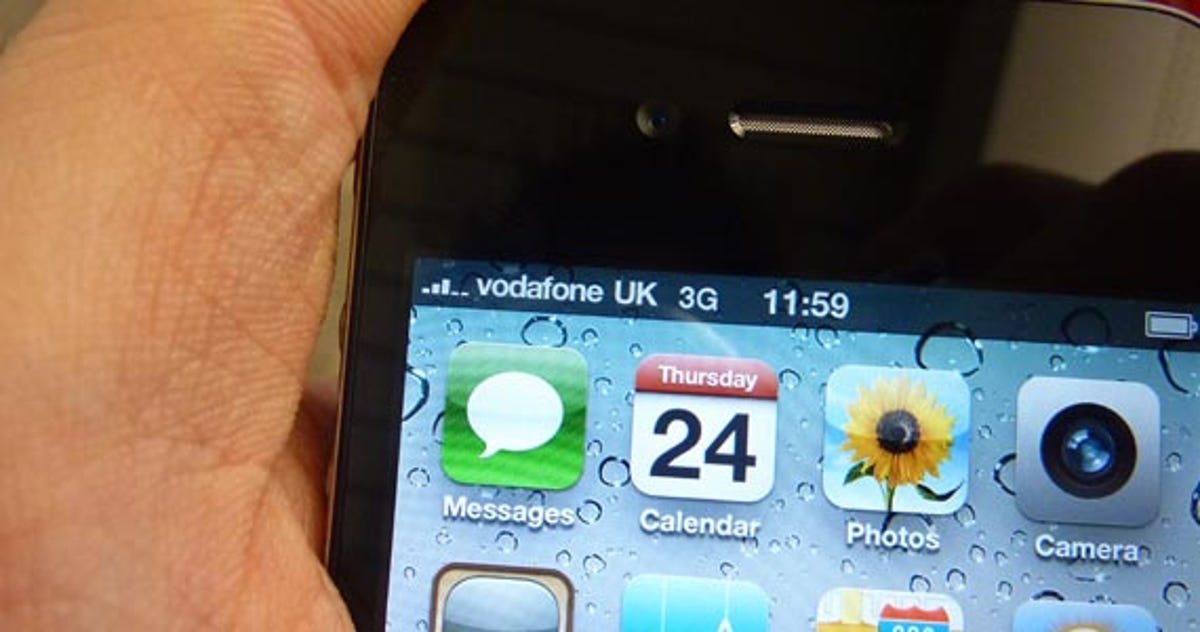
Are Apple’s claims about the iPhone 4‘s ‘Retina display’ — that it has a higher resolution than the human eye can see — nothing more than marketing hype, or truly the next level in display technology? As ZDNet UK’s Rupert Goodwins eloquently points out, the display in this phone is an LG LCD panel with in-plane switching (IPS) — no Earth-shattering magic here. So how good is it? We handed the iPhone 4 to our tame TV reviewer, and he gave it the once-over with his expert retinas.
First off, the iPhone’s pixel density is immense. Take a look at any 1080p TV close up, and you’ll be able to clearly see the individual sub-pixels. Squint as hard as you like at the screen on the iPhone and all you see is a smooth, continuous image.
It’s not hard to see why — according to our calculations, the iPhone has four times the resolution of a 1080p TV. If you were to make a 50-inch version of Apple’s 3.5-inch iPhone display, it would have a pixel count of 8,777,142. That’s roughly the same amount of detail you’d get in a 4K2K digital cinema. Put simply, we want a 50-inch one for our home TV as soon as possible.
Like many TVs and all mobile phones — especially touchscreen ones — the iPhone 4 has a protective layer over the screen. It’s made of glass, which is scratch resistant and gives a good surface to interact with the touchscreen. It helps to make blacks look blacker and colours more vivid too. It also turns the phone into the high-tech version of a lady’s make-up mirror. This layer is our least favourite part of the iPhone, and it’s the most likely to spoil your viewing experience in any environment that isn’t pitch black.
Comparing the iPhone 4 to the Google Nexus One is like night and day. The Nexus One uses an AMOLED panel that’s bright and colourful. It’s not especially accurate, however, and has problems relating to the way it’s constructed. If the Nexus One was a TV, we wouldn’t score it very highly, because it’s basically doing its own thing, without any regard for the original image or video. That said, phones aren’t TVs, and the Nexus One is bright and attractive, which is all most people want. The same is often true of LCD TVs — bright enough to burn through your cornea, and colourful enough to make a Tellytubby feel nauseous.
We tested an episode of the sci-fi show V on the iPhone, and the level of detail was utterly stunning. Mind you, on a small display, it’s easy to do a good job with average video. We were convinced the phone was displaying every ounce of detail possible. There’s no doubt this is the best screen ever fitted to a phone. We would really like to see some 1080p video on the iPhone — sadly the phone doesn’t support that, despite the hardware being capable of it. We crammed a 720p Star Trek trailer on the phone, and it looked jaw-droppingly good.
The IPS display also makes for very wide viewing angles. In our tests, the video was visible from every angle, in full colour, with almost no fade. There aren’t many computer monitors, phones or TVs that can claim that. With a phone that might not necessarily be a good thing though, as prying eyes on the train could easily oversee what you’re doing.
Ignoring Apple’s marketing hype over the Retina display, we can’t help but be impressed. When it comes to the human eye though, you simply can’t measure what resolution it can resolve. Indeed, some scientists say the resolution of the human eye is lower than 1080p, as our brain interprets what our eyes see and does a lot of post-processing on the incoming image. Whatever the truth, our eyes and brain are blown away by the iPhone 4 screen.



